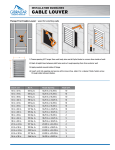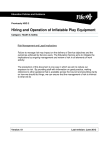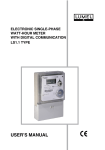Download NOAQ Boxwall User Manual
Transcript
User instructions NOAQ Boxwall BW50 1 (6) A NOAQ Boxwall is a self-anchoring, mobile wall that provides flood protection. The NOAQ Boxwall BW50 creates a dam for water up to a height of 50 cm. The boxwall is so light that it can quickly be set up to protect buildings and other property against water damage, and also to keep roads open. A boxwall is designed for use on an even, firm surface, such as a paved street or a concrete floor. The boxwall is patent-protected in a large number of countries. A boxwall consists of sections (boxes) that are linked together by means of a simple manual operation. Each joint is then fixed using a special clamp. Each box consists of a damming part (the rear wall), an anchor part (the horizontal section that rests on the ground) and a sealing part (the front edge of the horizontal section. Sealing strips of cellular plastic are fitted under the front and side edges. Each box is also fitted with a pair of cellular rubber soles to create a good grip on the road. A boxwall is built up by snapping boxes one at a time onto the previous one. The easiest way is to work from left to right (viewed from the dry side). You should avoid working from two directions, as it is difficult to make the two wall sections meet at exactly the same point. 2 (6) The boxes are easy to handle and move, and you can also adjust the setting of a constructed boxwall as long as the water has not started to press firmly against the base. But you must avoid dragging the boxes on the ground, as the sealing strips on the underside are vulnerable to wear. This is how a NOAQ Boxwall works The base section of the boxwall is pressed firmly against the ground by the weight of the flood water. There is a pair of cellular rubber soles on the underside to provide a reliable grip on the road. Sealing part Anchor part Damming part Beneath the front edge of the boxwall is a sealing strip made of cellular rubber. This keeps the leakage of water at the bottom to a minimum. The anchoring force is proportional to the difference in water pressure between the upper and lower side of the boxwall. A system of drainage channels on the lower side diverts the leaking water, so that no counter pressure arises. The rear wall dams the flood water. The water’s pressure is absorbed by a couple of large bulges, which also act as drainage channels. Follow these instructions: 1. Inspect the area where the boxwall is to be constructed The boxwall has been specially designed for hard, even surfaces such as asphalt and concrete. It is therefore ideal for setting up on streets and paths, across car parks, in industrial areas, around shopping malls, in harbours and at airports. It must not be used on uneven surfaces or on ground that is prone to erosion. “Gradual” unevenness is not a problem, but if there are sharp irregularities such as holes or bumps, you must either avoid passing over them or even them out in advance. Loose sand and gravel must be brushed away from where the wall is to be laid. The soles attached beneath each box have just as good a grip on the road as the rubber soles on your shoes. If there is sand on the road surface you run the risk of slipping, and the same applies for the boxwall. Curves can be created by linking together the individual boxes at various angles. A boxwall can thus be set up alongside a winding road, but can also take a 90° turn into a connecting road. A curve in a boxwall may not, however, be too sharp. The minimum curve radius is 12 metres. Outward corners can be made using a certain Corner Support, see below. The boxwall can be placed on land that is already flooded, but if the ground surface is difficult to see, you must take particular care to make sure that the boxes are not placed on uneven surfaces, on the wrong side of surface water drains, etc. 3 (6) 2. Lay out the boxes and connect them one by one. Start from the left (viewed from the dry side) and connect the boxes one at a time to the previous one. Use protective gloves! Some of the edges on the box are sharp. Locking mechanism The boxes have a coupling mechanism (at the front) and a locking mechanism (at the top). Tip the box slightly forwards and connect it with the previous box by inserting the protruding “tongue” (on the far left) beneath the “bridge” (at the very front on the right-hand side of the previous box). Then press down the rear edge of the box until the locking mechanism’s protruding pin snaps into the groove in the previous box. The boxes are now linked, but can still be turned +/-3° against one another. This is how curves can be created. Coupling mechanism Secure the position of the boxes in relation to one another by placing a clamp over each joint. This is not absolutely necessary. The boxwall will still work, but in the event of high water levels and wave action the clamps will also help to secure the zone around the joints. To help the sealing strip underneath create a tight seal against an uneven surface, you can place a weight on the front edge of each box, for example a sandbag. This has the best effect if it is placed on top of the joint zone (the “bridge”). It can also be necessary to ballast the boxes in this way if there is a strong wind, before the water arrives. The boxwall is not very susceptible to winds coming from the front, but winds from behind will try to lift it. If you want to further improve the seal, you can also cover the front edge of the boxwall with a broad strip of thin plastic film and fix it into place with a line of gravel or a row of sandbags. 3. Connect to wall or façade. When a boxwall needs to end in deep water, like against a wall or a façade, the outermost box must be supported from the rear. If the boxwall is connected alongside a wall or at an oblique angle to it, it is provided with support by the wall itself. If it connects at a right angle or at a sharp angle, a gable section (a section of the NOAQ Gablewall) is recommended. Another option is bolting a plank to the façade, as support, or placing something heavy behind the last box. Some kind of sealing strip must be placed between the box and the wall to reduce water leakage. A pair of cellular plastic strips are supplied with each order for this purpose. 4 (6) 4. Kerb stones. Kerb stones or minor steps can be passed using gable sections. The passage must be made at a right angle. Two between themselves reversed gable sections are put together, side by side, one at the higher level, the other at the lower level, and connected. The boxwall part standing on the street will be supported by the lower gable, while the part standing on the sidewalk will be supported by the higher gable section. 5. Lenght adjustments. Gable elements can also be used to adjust the length of a boxwall. If the boxwall needs to have an exact length, like between the two opposite walls of an entrance, the length of the boxwall can be adjusted by putting a gable element in each end and let the boxwall overlap those to a smaller or larger extent. If this is not enough the length can be adjusted further by dividing the boxwall in two and inserting a pair of gables inbetween. Also in this case the two gable elements are reversed between themselves, connected side by side and screwed together. 6. Corners. Outward corners can be created by the use of a certain Corner Element. Place the corner element where it is supposed to be located, and connect a boxwall section from each direction. Fix with a couple of screws in the lower part and a couple of clamps in the upper part. If the corner needs to have an exact position the two boxwall parts may need to have their length adjusted according to the description above. 7. Pump away leaking water. There will always be some leakage. If the ground is level or slopes towards the flood, this water must be pumped clear with a pump. If the ground slopes away from the flood (e.g. on the crown of permanent embankments), the water will run away without the need for pumps. Be aware of any surface water drains. The boxwall should ideally be laid behind any of these. If there is a risk that surface water drains or culverts might divert the flood water under the wall and into the protected area, these channels should be plugged or blocked in a suitable way in order to reduce the need for pumping capacity. 5 (6) 5. Combine boxwall and tubewall. A NOAQ Boxwall can be combined with a NOAQ Tubewall. The walls are laid so that they overlap by a metre or so, ideally with the tubewall closest to the flood and the boxwall beneath and behind the tubewall. One or a pair of the tubewall’s joint covers are used to form a seal between the two wall sections. The joint covers are used in the same way as when the tubewall connects to a wall (see the user instructions for the tubewall). 9. Flash flooding. The boxwall can also be used in flash flooding, when water is running fast over the streets. When this happens the most obvious measure is to protect low entrances and vulnerable objects by redirecting the water flow toward areas where flooding will cause less damage. A similar situation can occur when snow is melting, and the water tries to take unacceptable routes. As for the use in calm water, the boxwall should only be used on hard and even surfaces, like paved roads. If water is already running fast at the place of the intended action, the first measure would be to place a number of boxes in the water flow, to break down the speed of it and reduce its power. Put the boxes close to each other, facing upstream, but do not try to connect them. They will be anchored directly by the weight of the water entering upon them. Behind this protective row of boxes a continuous boxwall is then assembled. When the boxwall is completed, the front row of boxes can be removed. This way the boxwall can be used to lead away watermasses in a controlled manner down the streets, hereby reducing water levels and flood problems upstream. To divert the water off the street the boxwall may be deployed diagonally. The angle chosen, in relation to the direction of the current, depends on the amount of water and the speed of it. 6. After use. Disconnect the boxes by pressing down the locking mechanism’s pin out of the groove. The easiest way is to pull simultaneously on the vertical edge of the box, half way up. If you are using a tool, for example a screwdriver, you must take care not to damage the pin (or yourself). Rinse the boxes clean using a garden hose or by rinsing them in water, and stand them on their side to dry (when they are placed on the side the water runs off more quickly from the 6 (6) pores in the sealing strip). If there is a risk of temperatures falling below zero, the boxes must be taken indoors and stored in a heated area until all “soft parts” (soles and sealing strips) have dried out properly. Inspect all soft parts. Damaged or worn sealing strips can be replaced, but if the soles have suffered big damage, the entire box should instead be replaced. The boxes can be stacked to take up as little space as possible during transport and storage. Important! Floods result from a course of events controlled by forces of nature that can only be controlled to a limited degree. Furthermore, no two events are the same, which means that all protective equipment must be used not only with good knowledge of its function and limitations, but also with generally sound judgement. Those who provide the equipment, manufacturers, resellers, hirers, etc. can never accept liability for the actual use and any possible personal injury or damage to property that might arise.
















